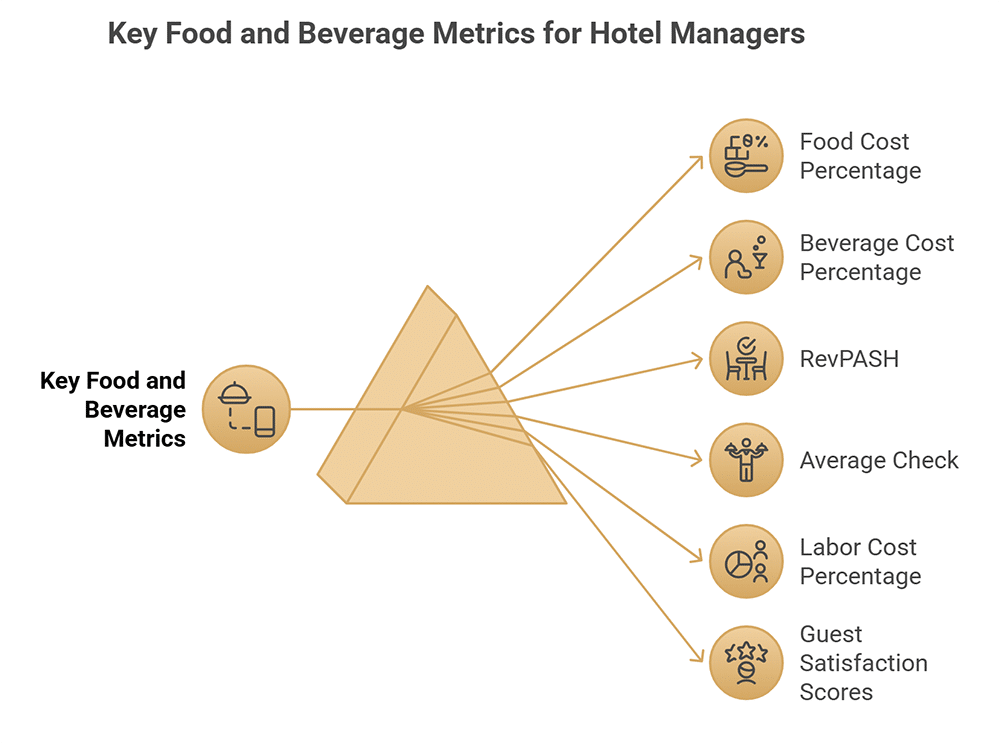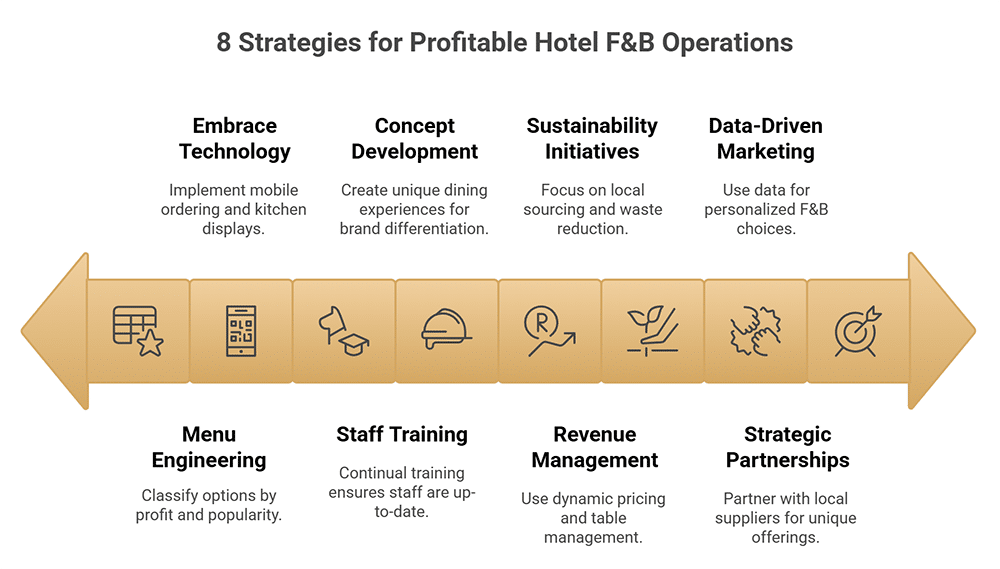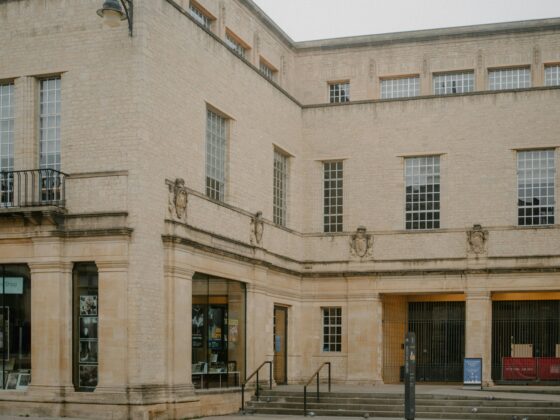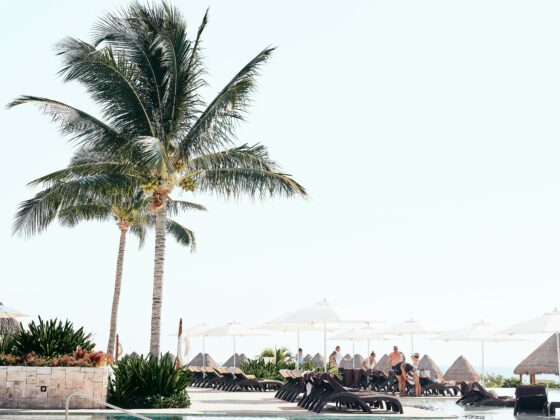Food and beverage (F&B) services are the lifeblood of the hospitality industry. A good meal is one of the cornerstones of the human experience and colors every other element of a guest’s day. Food and beverage services help differentiate you from the competition, provide a steady revenue stream, increase guest loyalty, act as a marketing tool, and generally enhance almost every aspect of a guest’s stay.
In this article, you’ll discover how to leverage F&B services to optimize a guest’s experience, maximize profit, and ensure the health of your brand.
Table of Contents:
What is the Role of Food and Beverage in the Hotel Industry?
Food and beverage services may seem like a minor aspect of a hotel from an outsider’s perspective. However, in reality, F&B services drive approximately 25% to 30% of a property’s total revenue, according to the 2025 AHLA State of the Industry report. This level of profit is due in part to the sheer scope of the services. Food services include bars, restaurants, banquet-related elements, room service, catering, and more. However, these elements aren’t simply added to a hotel. The hotel industry typically puts considerable work into properly integrating all of these services into its larger infrastructure. The hotel’s standards, branding, billing, and overall ambiance all need to work seamlessly alongside every other element of the property.
Why Food and Beverage Management is Important for Hotel Success?
Food and beverage services color every aspect of a guest’s experience throughout their stay. Meals help build emotional connections with your guests, which translates into a competitive advantage. This, in turn, also influences how likely they are to make return visits, book directly, and tell others about their positive experiences.
F&B services boost your brand, increase guest satisfaction, and increase your overall profits by providing an additional source of revenue. The positive impact of culinary services also helps to make your property distinct from the competition. Guests don’t simply remember the meal; they also remember the experience. They remember an enjoyable experience set within that specific time and place. An experience perfectly tied to your brand. Likewise, guests are often eager to share those memories over social media.
How Food and Beverage Innovation Improves Customer Satisfaction?
Food makes a big impact on your guests’ stay, whether it’s gourmet food, premium drinks, or snacks. Hospitality dining spaces, your ideas for unique offerings, your presentation, and the company guests enjoy will create lasting memories that make their stay distinct from your competition. According to NIQ research, when innovation sales grow, a property is 1.8X more likely to grow overall sales compared with companies whose innovation sales are stagnant or declining.
The more unique the experience, the more these good memories are tied to your brand. As such, investment in culinary innovation is an investment in marketing. Guests will come back to enjoy a positive experience. They’re even more likely to do so if you’re continually innovating and adding enticing new options. Today’s traveler is especially eager to sample new experiences, and innovative culinary design is a fantastic way to entice their curiosity.
Video: Food and Beverage Department: Hotel Management
How Food and Beverage Shape the Guest Experience
The hospitality industry should always seek to evoke emotion. A guest’s positive feelings become tied to the venue, which evokes them, and there are few more reliable methods of doing so than food and beverage services. Everything from the first dinner to the last breakfast in a hotel can stick with guests long after they’ve returned home. The design of your food services can even create a structure to support the type of emotion you wish to evoke. An important element of that design is the fact that the guest experience also provides a revenue stream through multiple points.
Even examining the culinary options can provide a feeling of adventure and discovery as guests move about your property to consider their choices. Full services for breakfasts, after-hours drinks, and more help ensure guest spending stays within the hotel. It can also demonstrate care through cultural and dietary considerations. If you want to learn more about the connection between the guest experience and a hotel’s revenue, read “How Guest Experience Drives Hotel Revenue (and How to Maximize It).”
Key Food and Beverage Performance Metrics for Hotel Managers
Metrics are an important part of any optimization effort. The following food and beverage metrics indicate how your strategies are helping and show you areas for further optimization.
- Food Cost Percentage: A comparison of food sales to food cost in order to reveal pricing and preparation optimization, with a general target of 28% to 32%.
- Beverage Cost Percentage: This beverage version of the foodservice industry food cost percentage metric shows effectiveness in drink pricing, especially with bars, and ideally sits at 18% to 24%.
- Revenue Per Available Seat Hour (RevPASH): A combination of average check and table turnover, which highlights the per-seat revenue generation to show areas of dining capacity utilization ready for optimization.
- Average Check: A food and beverage metric that shows how effective upselling and price point appropriateness are by dividing the total sales by covers.
- Labor Cost Percentage: Measures total food and beverage revenue against labor costs to generate metrics on staffing efficiency, aiming for 30% to 35%, depending on the service.
- Guest Satisfaction Scores: Predict future performance and areas for optimization by tracking guest satisfaction using online reviews and surveys.

8 Strategies for Profitable Hotel F&B Operations
Food and beverage options can provide you with a significant revenue boost. However, doing so requires careful planning to get the most out of the services. The following strategies will ensure that you’re helping guests and your profit at the same time.
1. Implement Menu Engineering Techniques
Hotel dining provides you with a unique opportunity to carefully curate guest options to ensure both profitability and satisfaction. Make careful use of metrics to classify options by profit and popularity. Common categories include stars (high profit and popularity), puzzles (low popularity but high profit), workhorses (high popularity with low profit), and dogs (low profit and popularity). Strong food and beverage strategies leverage these categories by using psychological and marketing techniques to set the placement of items on a menu, pricing, and evocative descriptions. All of these elements can influence what a guest chooses and help you drive items that will lead to the best results.
2. Embrace Technology Solutions
Technology isn’t just useful for preparing food and beverage options. It impacts almost every part of the process for both you and your guests. Software integrations are especially significant as point-of-sale packages can work with your other software, like property management software (PMS), to create a synergistic whole. For example, integrated solutions make it easy to accept guest payments while also saving data related to their spending habits. This allows for purchases related to dining to be instantly available alongside other spending in the property. Mobile ordering, kitchen displays, and tableside payment provide even more options. On the other hand, automation can reduce both spending and waste by monitoring inventory and order processing.
A case study from Hilton Omaha demonstrates the impact of contactless dining technology. As one of the first properties to beta test QR code ordering in late 2019, the hotel saw a 240% increase year-over-year in F&B revenue during the pandemic and a significant reduction in menu printing costs. The property leveraged GoTab’s contact-free ordering features to operate lobby bars, coffee shops, door delivery, and tableside dining.
Video: Food and Beverage Industry | Hotel Business
3. Develop Staff Excellence Through Training
Just as the food and beverage options shape a guest’s experiences, so too should your employees’ training shape how they present the various options. Think of the hospitality training as an ongoing process rather than just a one-time event. Continual training will ensure staff are up-to-date with options and technologies while also understanding which items to upsell. Your staff should be as knowledgeable about your options as catering and beverage services. If a guest has a question about anything from menu items to wine pairings and even dietary considerations, then your staff should be prepared to provide useful advice and expert opinions. Taken as a whole, these elements will help your staff create a fantastic experience that guests will remember and want to enjoy again. If you want to learn more about how to create a skilled and competent staff, read “Hospitality Training: 20 Need-to-Know Courses to Train Your Staff.”
4. Create Distinctive Concept Development
Distinct food and beverage options, when handled correctly, are a powerful way to differentiate yourself from the competition. When guests enjoy an experience that’s unique to your property, they’re going to consider it part of your brand. Just as people have a favorite restaurant, they’ll often have a favorite hotel dining experience that keeps them coming back. You should hone your selection to the point where it becomes destination-worthy, something that people will plan for in and of itself. New and emerging culinary trends, traditional dining options, competitive positioning analysis, and signature dishes or drinks can all help to create a truly memorable experience for guests. Likewise, ensuring the visual appeal will compel guests to post pictures on social media.
5. Optimize Revenue Management Practices
There are a number of effective methods to optimize your food and beverage systems through revenue management techniques. Using metrics to project demand, careful pricing design, and capacity utilization are all especially powerful. Consider dynamic pricing designs that adjust the cost of various items based on time of day, spikes in demand, and ongoing events. This helps you earn more during peak moments. Table management will also help you ensure your seating capacity can best fit guest needs. If you see downward spikes, consider using promotions to attract guests to the table. Likewise, ensure you’re leveraging guest data to analyze spending patterns and create package offers. If you want to discover how F&B services can drive hotel revenue, read “How to Use Food and Beverage F&B Data to Increase Hotel Revenue.”

Nicole Sideris, Founder & Principal Consultant, X Hospitality“Hotels can use their F&B outlets as part of their book direct strategy, for example, by offering all direct bookings a free cocktail, a complimentary breakfast, even a $ Voucher. Food and beverage offerings can be marketed to the guest across the whole customer journey: at the reservation stage with a package or add-on, at the confirmation stage with an offer in the confirmation message; they can be included in the pre-arrival stay list, and then during the stay, they can be highlighted in-house via elevator advertisements and upgrades, and then finally at departure, they can be included in a “stay again” offer.” Click here to learn more F&B services integration tips from our Hospitality Expert Panel. |
6. Focus on Sustainability Initiatives
Sustainability in your food and beverage operations is a powerful draw for eco-conscious or health-focused guests. However, it can also save you money by opening up local supply chains to bypass traditional sourcing. Buying local also provides inherent benefits such as freshness and might even give you a chance to leverage local stories and history for your guests’ enjoyment. Waste reduction will also help with these elements while providing benefits through composting, portion control, and even partnerships for food donation. Authentic sustainability is a powerful draw for guests that also helps you save money, increase food quality, and create business connections within the local community.
7. Leverage Strategic Partnerships
Aim for partnerships with beverage brands and local suppliers or producers of all sizes. Partnerships and trust open the door to limited-release items, unique ingredients, specialized offerings, and more. This is an especially important way to work with local artisan options and farmers to present the area’s unique flavor to guests. For example, The Ritz-Carlton mobile app demonstrates innovative partnerships through QR codes that encourage guests to explore hotels by offering site-specific data and promotions. Guests can scan QR codes on napkins to get cocktail recipes, take art collection tours, or learn about wine pairings.
8. Implement Data-Driven Marketing Strategies
New technologies, such as cutting-edge property management systems, can combine multiple income sources from your property into a unified whole that’s ideal for data-driven strategies. For example, you can consider reservation patterns alongside dining histories to form a better picture of a guest’s needs. Make the most of your data by using personalized options for food and beverage choices, which can directly target specific demographics while also tracking conversion rates. This strategy can help boost restaurant occupancy in current or projected slow periods. IHG’s food and beverage rewards program allows members to apply credits against F&B purchases. Their redemption data shows how properties can drive incremental revenue through targeted loyalty offerings.

How Food and Beverage Trends are Reshaping Hotel Dining
Hoteliers can attract and keep guests by staying current with the latest food and beverage trends. The following are among the most important things for guests.
- Plant-Forward Menus: Move past strict plant-based offerings to provide vegetable-focused items for health-conscious diners and flexitarians while also minimizing costs.
- Hyper-Local Sourcing: You can use local artisan sources, ingredient foraging, and on-property gardens to reach a level beyond farm-to-table for guests who are eager to pay for the freshest foods.
- Experiential Dining: Create full experiences with tableside preparation, interactive food stations, chef’s tables, and other events that also make for great social media marketing opportunities.
- Craft Beverage Programs: Craft beer partnerships with locals, signature cocktails made in-house, and even “zero-proof” non-alcoholic drinks can match the needs of sophisticated palates while increasing overall profits.
- Technology Integration: Newer technologies like digital menus, mobile apps for ordering, and contactless payment meet guest expectations while also giving you increased efficiency and data for personalized marketing.
- Flexible Dining Formats: Leverage multipurpose spaces that can be used for different functions beyond a three-meal restaurant format to both optimize profit and innovate.
Video: What’s Next for Hotel Food and Beverage?
Food Ordering System: How to Choose the Best One for Your Property?
Food ordering systems are a significant game changer for a hotel’s general food, restaurant, and bar services. Streamlined technologies can integrate food and beverage services with the larger hotel as a whole. In doing so, you create a user-friendly service for guests that boosts satisfaction and purchases. You can discover how to review, select, and deploy these options in the article “Food Ordering System: How to Choose the Best One for Your Property?”
Discover the Latest Restaurant Technology Trends
Technology and the modern food service industry have become inseparable. To maximize the benefits of food and beverage services, you must also leverage the most effective technologies related to them. You can enhance a guest’s dining experience, boost profits, optimize the kitchen, and increase engagement by using high-tech tools. The best high-tech solutions for the industry can be found in the article “Discover The Latest Restaurant Technology Trends for 2025.”
Food and beverage services are an important tool to build guest loyalty and profits through unique experiences that solidify your brand. Consider what you’ve learned so far and how you can build on your current foundation to further your success.
Did You Like This Article about Food and Beverage Services?
You might also be interested in the following articles:
More Tips to Grow Your Business
Revfine.com is the leading knowledge platform for the hospitality and travel industry. Professionals use our insights, strategies, and actionable tips to get inspired, optimize revenue, innovate processes, and improve customer experience.
Explore expert advice on management, marketing, revenue management, operations, software, and technology in our dedicated Hotel, Hospitality, and Travel & Tourism categories.
This article is written by:
Hi, I am Martijn Barten, founder of Revfine.com. With 20 years of experience in the hospitality industry, I specialize in optimizing revenue by combining revenue management with marketing strategies. I have successfully developed, implemented, and managed revenue management and marketing strategies for individual properties and multi-property portfolios.









